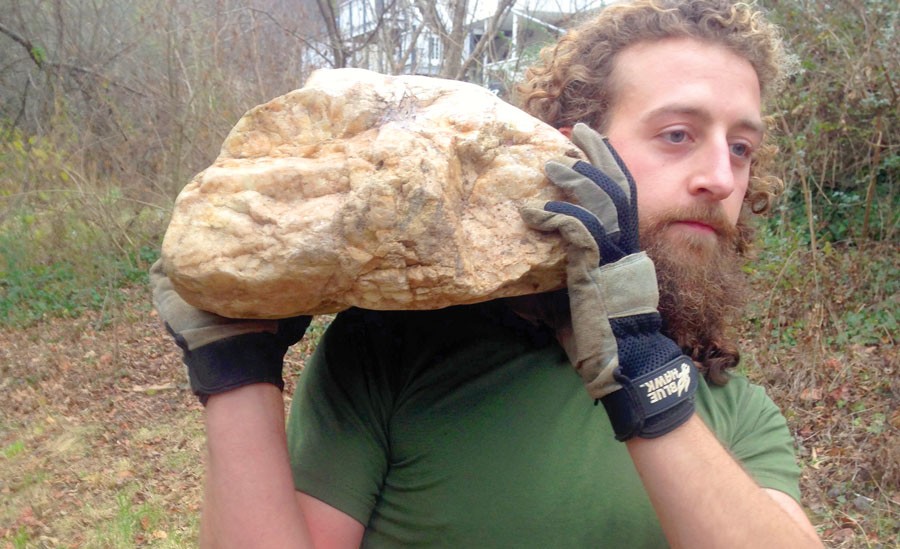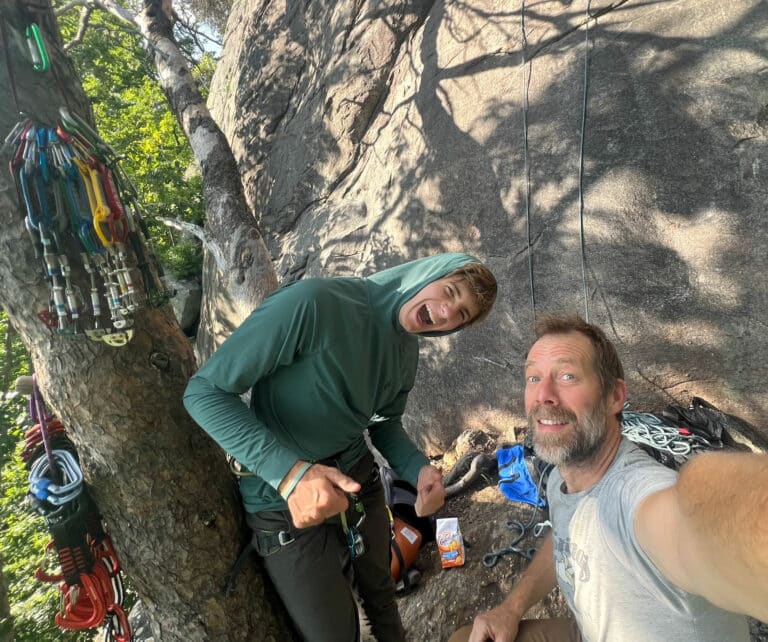The gym sucks. You know it, we know it. And yet many of us still feel compelled to spend time inside “the box,” throwing up free weights or pushing belts on machines in the ever elusive pursuit of strength. Maybe you’re a climber with a burly project looming. Maybe you’re addicted to your carbon road bike and the next Strava record. Maybe you’re a runner looking to P.R. Whatever your passion, strength is important, whether you realize it or not.
“A lot of endurance athletes don’t want to take any time or effort away from their sport for strength training,” says Samantha Stone, a certified personal trainer and founder of Functional Fitness Asheville. “But strength is important. We’re talking about stability of the structure. These sports are repetitive. You strike the same part of the body over and over, if you don’t have the strength or stability in the structure, it’s going to wear out over time. “
So you need muscles. But do you need the gym? Not at all. Stone teaches regular strength training classes outside, using parks, forests, and city-scapes as her gym.
“If you’re looking to compete in strong man competitions, you need the gym. But if you’re an athlete looking to get stronger so you can move and play more effectively, you don’t need the gym at all,” Stone says.
The takeaway: If you want to be a better mountain athlete, you’re better off training in the mountains. We talked with Stone and other athletes and fitness experts to create BRO’s first outdoor training guide. Read on, and maybe, finally kiss the gym goodbye.
Stone’s Functional Fitness
In Stone’s functional fitness classes, one day, she might incorporate strength exercises into a group run. The next, she might use playground equipment as her strength inspiration. “We’d find benches, stairwells, railings, scaffolding, swing sets—anything we could use to create resistance.”
We asked her to design a short workout for athletes who want to leave the gym behind. She came up with this plan that focuses on mobility, core recruitment, and training the fast-twitch muscle fibers. Bonus: It’s fast. The whole workout will take less than 30 minutes.
Core
- Planks Pushup position, holding back flat. Build up to 3:00 minutes.
- Hanging Leg Raises Grab a pull up bar, monkey bar, or tree limb and hang. Keep your knees straight as you raise your legs until they’re parallel to the ground.
- Wall Push Push as hard as you can against a wall for 10 seconds at a time, keeping your core and butt tight.
Fast twitch
These exercises focus on explosive movements. If you’re just beginning a strength-training program, start with slower movements and progress to power oriented training.
- Do: 3-6 sets with 10 reps per set.
- Squat Jumps: Keep your heels grounded and back straight as you drop into a squat. Then explode up and off the ground. That’s one.
- Step Ups: Find a bench and step up, bringing your other knee to your chest. Alternate. That’s one.
- Jumping Lunges Drop into a lunge, where your back knee is almost touching the ground. Explode up, switching your feet in mid air and landing in an alternate lunge. That’s one.
- Explosive Pushups Your standard push up, but explode up, so your hands leave the ground. Clap if you have rhythm.
- Pull Ups If you can’t perform a straight pull up, cheat by jumping into the pull up.
Work Out Like a Farmer
You really want to build strength and power without stepping into a gym? Work out like a farmer. Jason Harle is a strength and conditioning coach and founder of The Farmer’s Gym, an online destination and coaching service that uses the farmer’s life as the foundation for strength training. Harle just published the The Farmer’s Gym Almanac, a collection of outdoor workouts based on farm life. Hale grew up on a farm and asserts that mimicking the daily farm routine will allow athletes to reap huge strength and fitness benefits without any costly equipment or gym memberships.
“It’s about getting back to the basics, and doing work. A farmer taxes every muscle through the countless tasks in a given day—lifting bales of hay, pounding fence posts, shoveling rock,” Harle says. “The book and the workouts I’ve created are designed to test the body in the same fashion.”
The Farmer’s Gym Almanac has more than 400 exercises, most of which focus on body-weight movements. A typical FGA workout includes about 20-25 minutes of high-intensity multi-exercise interval training, using a combination of old staples like push-ups and pull-ups to more creative exercises like the “dragon walk” and “floor wipers.” Harle also includes kettlebell exercises, which he says is the perfect substitute for the farmer’s feedbags or bales of hay.
Here are five farm-friendly exercises, and their modern-day interpretations, that build muscle and functional fitness.
- Throwing Bales of Hay Deadlift a sandbag and hoist it chest-high, then throw it as far as you can (think about throwing a chest pass in basketball). Do this several times. No sandbag? Use a big rock.
- Shoveling Rock or Dirt No substitute here—just grab a shovel and head to your backyard. Dig a hole for five minutes, then fill it up. Repeat.
- Hammering Fence Posts Grab a sledgehammer and an old tire and start wailing on it. Try to create a steady rhythm to your swings, using your legs and core in addition to your arms and shoulders. No tire? Hit the ground.
- Chopping Wood Again, no substitute for an axe and a log. Get chopping.
- Farmer’s Carry Find a rock—something heavy. Deadlift it and and carry it in front of your waist, walking across your yard. Drop it, shake your arms out, then repeat the process.
Go OCR: Obstacle Course Racing
Obstacle Course Racing is fun, exhausting, and the next day you wake up sore in places you didn’t even know you could be sore. What the hell is that muscle on your elbow called, anyway? Obstacle Course Races might just be the perfect workout. Just ask Andi Hardy, a former teacher turned semi-pro obstacle course racer who’s racked up more than 40 races in just over a year, winning a lot of them.
“In obstacle racing, you have an element of endurance and stamina, but the races also incorporate high intensity intervals and strength training,” Hardy says. “You’re sprinting from one obstacle to the next. Thirty slam balls. Sprint. Rope climb. Sprint. It’s the perfect mixture of strength, speed, endurance, and mobility.”
And more importantly, fun.
“I like the variety and the surprises of the races, and I like to add that variety to my workouts,” Hardy says, adding that she trains twice a day, often on the fly and out in the wild. “The world is my gym. If I’m running Kennesaw Mountain, I look for ways to mix it up with pushups beside the trail. I’ll find a rock to jump over 20 times. I’ll walk across a log like a balance beam. I can train in my backyard, on the trail, even in the airport.”
In the spirit of variety, here’s a suggestion for a self-imposed training course circuit. You’ll need a park with a playground.
- Sprint a lap around the park.
- 10 Burpees (drop into pushup position, do a pushup, hop back to standing position, then jump as high as you can)
- Sprint a lap.
- 10 box jumps on a bench.
- Sprint a lap.
- 30 seconds of bear crawls (drop onto all fours, walk forward with equal weight on your hands and feet, keeping your hips low)
- Sprint a lap.
- 5-10 pull ups (use the monkey bars)
- Sprint a lap.
- Repeat until you’re no longer sprinting.
This plan is only a suggestion. Use your surroundings to determine the exercises you complete. Climb a tree. Find a rock and throw it. The options are endless.
Get the Legs of a Backpacker
There’s no doubt that hiking regularly will get you in shape. Look at your average Appalachian Trail thru-hiker. They start out soft and pudgy and finish lean and mean. Luckily, you don’t have to hike the ridgeline of the Appalachians to reap the strength benefits of thru-hikers. If you want the legs and core of a seasoned backpacker, start thinking like a Sherpa.
“Cross training is great, yoga helps, but there’s no substitute for having a pack on your back,” says Appalachian Trail speed hike record holder Jennifer Pharr Davis, who coaches would-be thru hikers through training regimens leading up to big hikes. Davis says there’s no way to emulate the torturous routine of a speed hiking record attempt, where you’re pushing yourself day after day. Instead of training nonstop, Davis adds weight.
“I’ll add weight to my pack, more than I’m planning on carrying on the trail,” the record holder says. “A couple of fire logs, an extra gallon of water. Then I set out for the most challenging routes I can find.”
Leading up to her record hike, Davis liked to train on big Mountains to Sea Trail climbs, particularly up Mount Mitchell and Black Balsam. The scenery will keep you motivated if you can train in high elevation surroundings like Mitchell, but it’s not required.
Load your pack with your normal weekend load, then add an extra gallon of water. Find a three-mile climb that gains at least 1,500 feet in elevation and start climbing. Don’t live near a trail? Climb stairs. Or find a steep hill and walk repeats with a loaded pack. The weight is the key, not the location of the workout.
An Argument for Heart Rate Training
“The biggest mistake athletes make is training too easy on their hard days and too hard on their easy days,” says Ben Friberg, a pioneer in long-distance standup paddle boarding who set the 24 hour SUP distance record. “Heart rate training gives an athlete immediate feedback about training effort, which ensures you are working at the proper intensity. Did you really push yourself? Are you pushing too hard, overtraining, and perhaps needing rest? When a big day comes, your ability to know how much fuel you are throwing in the fire will be beneficial.”
What you’ll need Nike, TomTom, Suunto, and Garmin all make GPS and heart rate tracking devices. Learn your resting heart rate, max heart rate, and calculate your personal heart rate zones.
Find the Zone After you know your numbers or zones, you can create workouts that are more effective. Short, fast intervals will push you to work hard, which will help to improve your speed. Base workouts are designed to improve endurance. Checking your resting heart rate first thing in the morning can even tell you whether you are recovering properly.
Go Anywhere Equipment
Kettlebell: Swings, carries, lifts, weighted squats—it’s as versatile as any piece of equipment out there. And it’s portable.
TRX: These suspension straps can elevate the simplest exercises, from pushups to speed skaters into full body core blasters. Hang them from just about anything.
Sandbag: Heavy, cumbersome—just carrying a sandbag across the yard is a full body workout. You can make your own with a sturdy duffel, or buy a kit.








